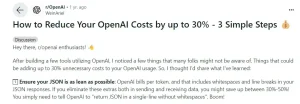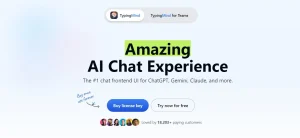Save up to 30% in your subscription with OpenAI API
The OpenAI API: A powerful artificial intelligence platform that provides access to cutting-edge natural language processing and generation models, enabling developers to build innovative applications and services with advanced AI capabilities.
How to reduce the cost of OpenAI Cost
i – Tricks are what we like to call direct ways to reduce your subscription costs.
1️⃣ Ensure your JSON is as lean as possible: OpenAI bills per token, and that includes whitespaces and line breaks in your JSON responses. If you eliminate these extras both in sending and receiving data, you might save up between 30%-50%! You simply need to tell OpenAI to “return JSON in a single-line without whitespaces”. Boom!
Example: This Pokemon API JSON response is 210 tokens. After minifying it, we dropped to 117 tokens! This is almost 50% money saved.
Edit: As mentioned by u/brucebay, CSV format is also a good idea. No indentation and less repetitive characters.
2️⃣ Set temperature to 0 for structured responses: When expecting a structured response (like JSON), setting the temperature parameter to 0 helps the model strictly stick to your expected JSON structure. This will prevent cases where you expect JSON, but something went wrong, and OpenAI responds with “Sorry, I am not sure I can …”.
3️⃣ Robots don’t need you to be polite: Computers understand simple instructions well. Trimming redundant/filler words from your prompt can not only save money but also speed up execution. Words like “please”, “kindly”, “really”, “very”, and so on, can often be dropped without losing accuracy.
Tip: You can use the OpenAI Tokenizer to count the tokens of your requests/responses.
Source: https://www.reddit.com/r/OpenAI/comments/13scry1/how_to_reduce_your_openai_costs_by_up_to_30_3/

How to implement a Workaround to reduce cost for OpenAI API
i – A workaround is using another tool to reduce your subscription.
– We haven’t found any current workarounds to reduce your cost
If you are looking to reduce your teams OpenAI cost using a tool like https://www.typingmind.com/ could help reduce the direct OpenAI subscription cost.

Additional workarounds to try to reduce subscription costs:
Integrations with Free/Freemium Tools
Explore free or freemium tools like Zapier to automate tasks that might require additional licenses (e.g., basic data cleansing). Consider integrating with freemium tools like Slack for internal team usage
How to reduce OpenAI API via bundling
i – Use one tool to get a discount on another tool.
– We haven’t found any current ways to bundle your subscription
Additional bundling options to try to reduce subscription costs:
Pairing/Bundling for Discounts
Partner Programs: Check if your company qualifies for partner discounts through partnerships with other software providers (e.g., some cloud storage services offer discounts with Salesforce).
Negotiate with Support. Customer support details of OpenAI API
i – Speak with OpenAI support team and ask for a discount.
https://help.openai.com/en/articles/6614161-how-can-i-contact-support
Discuss Usage Patterns: Contact support and discuss your current usage patterns. They might offer discounts based on your specific needs and historical data.
Negotiate Renewal Rates: Before your subscription renews, negotiate renewal rates with support. Loyalty and commitment to the platform can sometimes lead to better pricing.
Use this for help: Customer support list or google
Switch to Alternative for OpenAI
i – Here is a list of similar products that are similar you can switch to for savings.
- Mistral is an open-source workflow engine that allows developers to define, execute, and manage workflows in their applications. It provides features for defining complex workflows using a simple and expressive DSL (Domain Specific Language), managing workflow executions, and integrating with various systems and services. Mistral is commonly used in cloud environments for orchestrating tasks and automating workflows across distributed systems.
- Anthropic is a company focused on developing artificial intelligence technologies with a focus on building systems that can understand and learn from complex data. They aim to create AI systems that are capable of reasoning, learning, and making decisions in a wide range of domains. Anthropic’s research spans areas such as natural language processing, computer vision, and reinforcement learning, with the goal of creating AI systems that are both powerful and aligned with human values.
- Groq is a semiconductor company that specializes in developing high-performance AI accelerators. Their processors are designed to efficiently execute machine learning algorithms, making them well-suited for tasks such as deep learning inference and training. Groq’s architecture is optimized for parallel computation, allowing it to achieve high throughput and low latency for a wide range of AI workloads. Their technology is targeted towards data centers and cloud environments, where performance and efficiency are critical for running large-scale AI applications.
Open-Source Solutions: Depending on your needs, explore open-source solutions that might offer similar functionalities at a lower cost. When searching try “Opensource for x” to find applicable tools.










